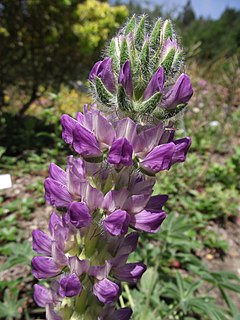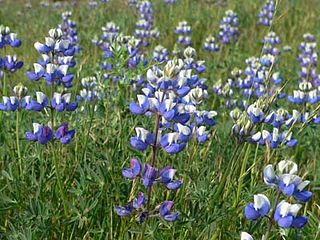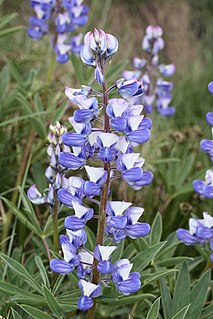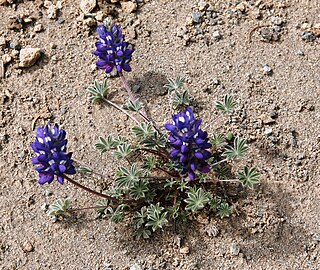
Lupinus polyphyllus is a species of lupine (lupin) native to western North America from southern Alaska and British Columbia east to Quebec, and western Wyoming, and south to Utah and California. It commonly grows along streams and creeks, preferring moist habitats.

Lupinus, commonly known as lupin or lupine, is a genus of flowering plants in the legume family, Fabaceae. The genus includes over 200 species, with centers of diversity in North and South America. Smaller centers occur in North Africa and the Mediterranean. They are widely cultivated, both as a food source and as ornamental plants.

Lupinus arboreus, common name yellow bush lupine (US) or tree lupin (UK), is a species of flowering plant in the legume family Fabaceae.

Lupinus arizonicus is a flowering plant in the family Fabaceae, native to the Mojave and Sonoran Deserts, where it can be found growing in open places and sandy washes below 1,100 metres (3,600 ft) elevation. It is common around Joshua Tree National Park and Death Valley National Park in California.

Lupinus microcarpus, the wide-bannered lupine or chick lupine, is a species of lupine native to western North America from southwestern British Columbia south through Oregon and California, including the Mojave Desert, and into Baja California. There is also a disjunct population in South America, with locations in central Chile and western Argentina.

Lupin or lupini beans are the yellow legume seeds of the genus Lupinus. They are traditionally eaten as a pickled snack food, primarily in the Mediterranean basin and Latin America. The bitter variety of the beans are high in alkaloids and are extremely bitter unless rinsed methodically.

Lupinus texensis, the Texas bluebonnet or Texas lupine is a species of lupine endemic to Texas, plus the Mexican states of Coahuila, Nuevo León, and Tamaulipas. With other related species of lupines also called bluebonnets, it is the state flower of Texas.

Lupinus nanus, is a species of lupine native to the western United States. It is found natively in California, Nevada, and on Steens Mountain in eastern Oregon. It tends to be found growing on slopes and in open or disturbed areas below 1300 meters. It grows 6 to 20 inches tall with blue flowers containing white or yellow spots. It is an annual plant that blooms in the months of March, April and May. It contains anagyrine and is considered toxic if directly ingested. Among the biologically active chemicals found in the pant are genistein, 2'-hydroxygenistein, luteone and wighteone.

Lupinus albus, commonly known as the white lupin or field lupine, is a member of the genus Lupinus in the family Fabaceae. It is a traditional pulse cultivated in the Mediterranean region.

Lupinus bicolor is a species of lupine known as the miniature lupine, Lindley's annual lupine, pigmy-leaved lupine, or bicolor lupine.

Lupinus excubitus is a species of lupine known as the grape soda lupine. Its common name refers to its sweet scent, which is said to be very reminiscent of grape soda. This species and its variants are found in Southwestern United States, especially in California and Nevada, e.g., Death Valley and Joshua Tree National Parks, and northwestern Mexico.

Lupinus albifrons, silver lupine, white-leaf bush lupine, or evergreen lupine, is a species of lupine (lupin). It is native to California and Oregon, where it grows along the coast and in dry and open meadows, prairies and forest clearings. It is a member of several plant communities, including coastal sage scrub, chaparral, northern coastal scrub, foothill woodland, and yellow pine forest.

Lupinus flavoculatus is a species of lupine known by the common name yelloweyes, or yellow-eyed lupine.,

Lupinus latifolius is a species of lupine known by the common name broadleaf lupine. It is native to western North America from British Columbia to Baja California to New Mexico, where it is common and can be found in several types of habitat. There are several subtaxa, described as subspecies or varieties, some common and some rare. They vary in morphology. In general this plant is an erect perennial herb. It grows 30 centimeters to over two meters in height, in texture hairy to nearly hairless. Each palmate leaf is made up of several leaflets, those on larger plants up to 10 centimeters long. The inflorescence bears many flowers, sometimes in whorls. Each flower is one to two centimeters in length, purple to blue to white in color, the spot on its banner yellowish, pinkish, or white.

Bluebonnet is a name given to any number of purple-flowered species of the genus Lupinus predominantly found in southwestern United States and is collectively the state flower of Texas. The shape of the petals on the flower resembles the bonnet worn by pioneer women to shield them from the sun. Species often called bluebonnets include:
Lupinus fulcratus, the greenstipule lupine, is a species of flowering plant from the order of Lamiales which is native to Nevada and California, where it is found in Sequoia and Kings Canyon National Parks.

Lupinus kingii is a species of Lupinus, family Fabaceae, which can be found in Arizona, Colorado, Nevada, New Mexico, Utah. Both the leaves and the pods are hairy with the later being 10 millimetres (0.39 in) long. In Utah, it is found only at Bryce Canyon National Park.

Lupinus lyallii, common names of which are dwarf mountain lupine, Lobb's lupine, and Lobb's tidy lupine, is a species of flowering plant from the order of Lamiales which can be found in California and elsewhere in western North America.
Lupinus magnificus, commonly known as Panamint Mountain lupine, is a species of flowering plant from the order of Lamiales.

Lupinus lepidus, the Pacific lupine, prairie lupine or dwarf lupine is a perennial herbaceous plant in the pea family (Fabaceae) endemic to western North America.



















